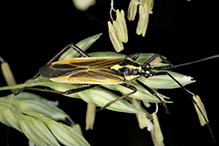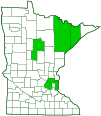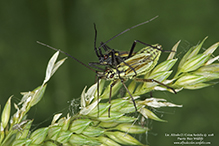meadow plant bug
(Leptopterna dolabrata)
Conservation • Description • Habitat • Ecology • Distribution • Taxonomy
|
|
||||||||||||||
Description |
Meadow plant bug is a common, widespread, terrestrial, plant bug. Adults are 5 ⁄16″ to ⅜″ (7 to 10 mm) in length. They are small bugs (order Hemiptera) but large plant bugs (family Miridae). Males and females are distinctly different in appearance. The head is shorter than the first segment of the thorax (prothorax). There is a single pair of large, compound eyes and no simple eyes (occelli). There is a transverse furrow between the eyes. The antennae are exposed, conspicuous, and long, much longer than the head. They have 4 principal segments and are covered with long hairs. The second segment is much longer than the third and fourth segments combined. On the female the second segment of the antenna is thinner than the base of the fourth leg segment (tibia). The mouth parts are optimized for piercing and sucking. They take the form of a long, 4-segmented beak. The beak rises from the front of the head and extends along the underside of the body between the legs. It consists of 4 hair-like blades (stylets) with sharp tips enclosed in a 4-segmented sheath. There are two channels in the beak, one spitting out saliva to keep the food flowing, and one for sucking in liquid food. The two lower jaw-like structures (maxillae) and two lower lips do not have feeler-like structures (palpi) attached. The body is soft and elongated. There are two pairs of wings, and they are held flat over the body when at rest. Between and at the wing bases there is a triangular plate (scutellum). On the male the wings are longer than and completely cover the body. The front wings are longer than the hind wings. They are black and yellow at first, darkening to black and orangish-red with age. On most females the wings are much shorter than the body. The front wings have a thickened section at the base and a thin membranous section at the tip with a clear dividing line between the two. The thickened basal part is comprised of a narrow area (clavus) behind the scutellum when the wings are closed, and the remaining broad marginal area (corium). At the end of the corium there is a small but distinct triangular area (cuneus). The hind wing is completely thin and membranous. The legs are covered with long hairs. The last part of the leg, corresponding to the foot (tarsus) has only 3 segments. |
Size |
Total length: 5 ⁄16″ to ⅜″ (7 to 10 mm) |
Similar Species |
Plant bug (Leptopterna ferrugata) male front wings are usually pinkish-brown. On the female the second segment of the antenna is equal in width to the base of the tibia. |
Habitat |
Prairies, meadows, agricultural fields, and other ungrazed grasslands |
Ecology |
Season |
June to September |
Behavior |
When disturbed adults emit a strong unpleasant odor. |
Life Cycle |
The female cuts into a host plant stem near the base with her ovipositor and deposits eggs in the stem. The eggs overwinter. When nymphs emerge in the spring they are wingless but otherwise similar in size and appearance to adults. They molt five times. |
Nymph Food |
|
Adult Food |
Mostly grasses (family Poaceae), but also Vaccinium sp. and vetch |
Distribution |
||
|
Sources |
|
| 9/22/2024 | ||
Occurrence |
||
Common and widespread, often abundant; agricultural pest on grass grown for seed |
||
Taxonomy |
|
Order |
Hemiptera (True bugs, Hoppers, Aphids, and Allies) |
Suborder |
Heteroptera (True Bugs) |
Infraorder |
Cimicomorpha |
Superfamily |
Miroidea |
Family |
|
Subfamily |
Mirinae |
Tribe |
Stenodemini |
Genus |
Leptopterna |
Subordinate Taxa |
|
|
|
Synonyms |
|
Cimex dolabratus |
|
Common Names |
|
meadow plant bug |
|
Glossary
Corium
The thickened basal portion of the front wing that lies between the clavus and the membrane of insects in the family Hemiptera. Plural: coria.
Prothorax
The first (forward) segment of the thorax on an insect, bearing the first pair of legs but not wings.
Scutellum
The exoskeletal plate covering the rearward (posterior) part of the middle segment of the thorax in some insects. In Coleoptera, Hemiptera, and Homoptera, the dorsal, often triangular plate behind the pronotum and between the bases of the front wings. In Diptera, the exoskeletal plate between the abdomen and the thorax.
Tarsus
The last two to five sections of an insect’s leg, attached to the tibia; the foot.
Tibia
The fourth segment of an insect leg, after the femur and before the tarsus (foot). The fifth segment of a spider leg or palp. Plural: tibiae.
Visitor Photos |
||
Share your photo of this insect. |
||
This button not working for you? |
||
Alfredo Colon |
||
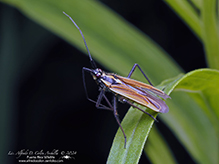 |
||
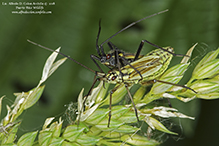 |
||
Bill Reynolds |
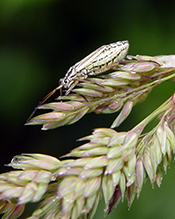 |
MinnesotaSeasons.com Photos |
||
|
||
|
||

Slideshows |
|

Visitor Videos |
||
Share your video of this insect. |
||
This button not working for you? |
||
|
Other Videos |
||
Langhaarige Dolchwanze (Leptopterna Dolabrata) www.Tierportraet.ch |
About
Published on Jun 20, 2012 Demo zum richtigen gebrauch des Saugrüssels. |

Visitor Sightings |
||
Report a sighting of this insect. |
||
This button not working for you? |
||
Alfredo Colon |
Location: Albany, NY |
 |
| Alfredo Colon 7/17/2018 |
Location: Woodbury, Minnesota |
 |
| Alfredo Colon 6/10/2018 |
Location: Woodbury, Minnesota |
 |
| Bill Reynolds 7/14/2003 |
Location: St. Louis Co. |
 |
MinnesotaSeasons.com Sightings |
||
|

Created: 11/4/2013 Last Updated: © MinnesotaSeasons.com. All rights reserved. |
